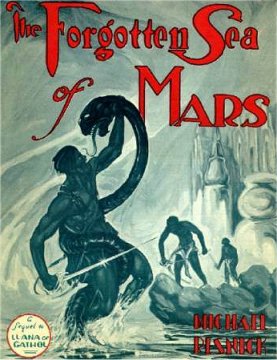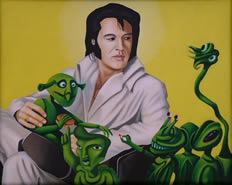All the Barsoom stories were written by Edgar Rice Burroughs
between 1912 and 1940. But Barsoom had a powerful hold on the
imagination. Writers beginning with Ralph Milne Farley and
Otis Adelbert Kline, continuing through with guys like Lin Carter and Mike
Resnick felt compelled to do their own Barsoomian tales, usually relocating
them to different planets - Venus, Ganymede, Callisto. But
there were also tales that were a thinly disguised Barsoom, as with Kline's,
Brackett's and Carter's Martian books.
Barsoom proved to be a powerful lure in its own right however.
There was something deeply rooted in Burroughs Mars. Perhaps it was
the breakneck writing, perhaps the sheer volume of the series and its consistent
quality, perhaps a by-blow of Tarzan's popularity... Perhaps it was
the simple historical fact that it was a seminal and groundbreaking series.
Or perhaps there was something compelling about the setting. Barsoom
is the old Mars of wonder and mystery, it speaks to a series of tropes
or assumptions, a sort of landscape that, like the Wild West, hasn't quite
died away for many of us.
A couple of generations later, other writers were returning to Barsoom
and mixing and melding it with other fictional Mars. Barsoom
irresistible for many writers, particularly those doing ‘omniversal’ pastiches.
Thus, Effinger's dimension travelling Maureen Birnbaum, Barbarian Swordsperson,
winds up visiting Barsoom. L. Sprague Camp's Harold Shea visited
Barsoom as well.
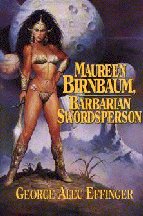
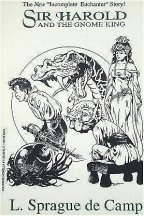
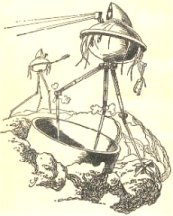
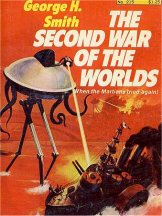
Of course it wasn't just Barsoom that writers were returning to.
Wells Martians proved, like cats, to have a few spare lives of their own,
either creatures inspired by them, or simple out and out re-uses of his
tentacled baddies. Notable among these was Guy N. Smith's Second
War of the Worlds. Notable for its badness.
But the interesting thing is that there were more than a few examples
of Barsoom mixing and matching, of writers asserting that Barsoom was also
the home of Wells’ Martians, or those of C.S. Lewis, or others.
In writing my notes on Greater Barsoom, I've acknowledged authors repeatedly,
whose modern works cross the different versions of Mars together.
Allow me to present to you Post-Modern Barsoom:
ALTERNATIVE
MARTIANS
 C.
Bertram Chandler wrote the first Crossover Barsoom that I know of.
It's possible that there were others.
C.
Bertram Chandler wrote the first Crossover Barsoom that I know of.
It's possible that there were others.
In Chandler's rendition, the Mars of H.G. Wells invaders, and the Mars
of Burroughs are the same world. The red martians and the green
men share their world with tentacled horrors. Or at least, they do
for a while.
Here's what happened. Apparently, in this Universe, the
Wells Martians invaded earth right on schedule. But instead
of dying from Earthly bacteria, they survived (or some of them did) and
brought the bacteria back to Mars.... And that was it for the
human or humanoid species on Mars. They were all wiped out.
Now, okay, Wells in his War of the Worlds had a humanoid species
of Martians. We don't actually meet them, but the tentacle guys brought
some along to suck on during the trip. At the end of the book, Wells
narrator mentions they've found the bodies.
But it's tempting, given Chandler's set up, to assume that these now
extinct Martians were Burroughs' red race. Certainly the cities that
have been left behind seem redolent of Barsoom.
John Carter would have arrived in 1865 and he would have had his critical
adventures in the first three or four novels before the invasion of Wells
Martians between 1898 and 1903. The invaders would have come
back bringing lethal invaders with them, and the undying John Carter would
have watched helplessly as his adopted people died all around him.
Dejah Thoris would have passed away in his arms. Imagine the
grief of a bereft John Carter, wandering empty cities, mourning an entire
world, the last representative of the red civilization. It
gives a shiver to think about.
Anyway, with the Red Race gone, the tentacled Sarmaks were left to dominate
the planet, pushing aside the nomadic green men. It's not clearly
spelled out in the novel, its possible that the Sarmaks have always ruled,
but this seems unlikely. In the novel, most everything we see
seems built and designed for humans or humanoids. The Sarmaks have
inherited their world, not built it. O'Brien, the human henchman
of the overlords notes that they have already grown helpless and decadent,
so clearly, they are on a fast trajectory.
But with the passing of the red race, they needed new slaves to populate
their world. So, the Sarmaks took them from England.
Thus, Mars is now populated by Cockneys and genteel Londoners.
It's sort of a weird thought.
The cockneys have proven to be pretty poor slaves, and so tribes of
them have split off into the wilderness. This is where we meet Bill
Carter, a tribal chieftain, and his princess, Dela Doris. They're
a far cry from John Carter and Dejah Thoris. Bill has a cockney accent
you could cut cheese with, he's a good swordsman, tough and nasty, but
not what we think of as a hero. Dela Doris is a bit of a shrew, a
bit of a fishwife, she's not the cultured scion of an urban civilization,
but rather, the product of a hardscrabble nomadic existence.
Still, she's a Princess, and Bill Carter's become leader of his tribe by
marrying her.
Tars Tarkas also appears, and this may well be the very same Tars Tarkas
of Princess of Mars. He speaks cockney, but he's also mastered
the well-spoken English of John Carter and the high class Brits.
Tars Tarkas is hanging out with Bill Carter and Dela Doris because the
nomadic Green Men are unwilling to challenge the dominance of the Sarmaks.
It makes you wonder, is it nostalgic sentiment that brings him close to
a Carter?
Of course, introducing bacteria to Mars has done more than simply wipe
out the red men. There's evidence that Mars has gone through another
wholesale extinction. Early in the novel, the visitors discover their
first Martian animal: A Rabbit. It seems that the Sarmaks have
had to introduce new species to replace the ones that have been lost.
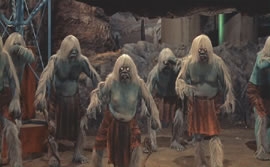 Humans
are not just slaves but the new foodstuffs. The Sarmaks have built
an elaborate British culture and caste system based on breeding people
as foodstuffs. Because there's a shortage of edible Martian
meat, the class system has turned to cannibalism with higher class Brits
eating those beneath them. There are overtones here of the cannibalistic
Morlocks of Wells' Time Machine.
Humans
are not just slaves but the new foodstuffs. The Sarmaks have built
an elaborate British culture and caste system based on breeding people
as foodstuffs. Because there's a shortage of edible Martian
meat, the class system has turned to cannibalism with higher class Brits
eating those beneath them. There are overtones here of the cannibalistic
Morlocks of Wells' Time Machine.
The whole result is a very warped, sometimes dark, sometimes comic take
on Burroughs Barsoom. Unfortunately, it doesn't quite come off.
The comic bits don't quite click. Chandler seems to think that having
Bill Carter speak with a thick cockney accent is just funny in and of itself.
And some of the Burroughs tribute doesn't work. Our hero is pitched into
a nudist society of slaves (the tunnels are warm and nudity keeps them
from being armed), performs feats of Earthborn strength and derring do,
and there's even a sword fight. But it all feels contrived, as if
Chandler has to really jimmy the plot around to make the situation happen,
where in Burroughs it all just came as natural as breathing.
As for the plot itself. Our heroes are from another universe
and accidentally cross over into an adjacent reality which is imperfectly
recorded in their fiction. In their world, Burroughs and Wells are
writers and "Princess of Mars" and "War of the Worlds" are novels.
The explanation is that information from alternate universes bleeds over
into the minds of writers, helping them to write their novels.
The information is often distorted, so instead of the noble John Carter,
we get cockney Bill Carter. But given Chandler's logic, it's clear
that Bill Carter is centuries too late to be Burroughs' hero. John
Carter may actually have existed in this reality.
Once they get to Barsoom, Burroughs-type things happen. The explorers
get separated, they fall in with different groups, encounter Bill Carter,
Dela Doris and Tars Tarkas. They wind up captured by the slave lords,
they have a sword fight, start a rebellion.... And then just
as things get underway, they go back to their own universe... Which
is disappointing. It's a very slim novel, and Chandler barely, barely
gets us invested in his adventure before he pulls us out of it. What
a tease!
The promotional descriptions and back of the book descriptions claimed
that the novel was a mixture of Wells, Burroughs and Otis Adelbert Kline's
Mars. To be honest, reading it, I didn't spot anything that
might be a direct reference to any of Kline's works. Perhaps I missed
something. Or perhaps the copy editors were a bit cagey. Kline's
Mars is pretty much interchangeable with Burroughs, and it may be that
claiming borrowing from Kline was a bit of a protective move to keep the
Burroughs estate from breathing too heavily down the publishers' necks.
After all, the only thing that they could really take from Wells are the
Sarmaks and a few of their machines. The setting of the rest of the
planet was pretty obviously Barsoom, unless you could find a bit of extra
cover, lawyers might become involved.
LEAGUE
OF EXTRAORDINARY GENTLEMEN
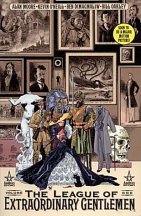 John
Carter and Gulliver Jones appear in the opening pages of the second volume
of Alan Moore's League of Extraordinary Gentlemen.
John
Carter and Gulliver Jones appear in the opening pages of the second volume
of Alan Moore's League of Extraordinary Gentlemen.
Moore's League is a remarkable series of comics.
Basically, it's a pastiche. Alan Quartermain and the Invisible
Man join forces with Captain Nemo, Jekyl and Hyde and Mina Harker.
Literally every page and every panel features a visual or verbal reference,
sometimes many, to some character or situation from the era of Victorian
fiction.
In the first series, in a literary feature at the end of each comic,
Allan Quartermain, having imbibed some dimension spanning drug, trips across
Wells' Time Traveller, Burroughs' John Carter (just before he arrives on
Mars), and H.P.Lovecraft's Howard Carter (who turns out to be John's nephew!).
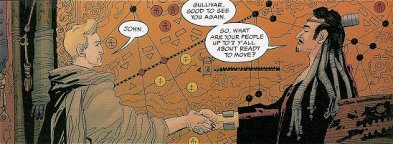 But
Carter doesn't burst into full four-colour life at the opening volume.
Instead, he has to wait for the first issue of the second volume.
It is only a slim comic but it tells quite a story. The situation
is dire: John Carter and Gulliver Jones are leading a crusade of Martians
against Wells invaders, the Sarmaks, here described as Mollusks.
The campaign has been brutal, something terrible has happened to Dejah
Thoris, referred to but not spelled out. The war is almost
at an end, the Mollusks are pushed to their final fortress.
Carter and Jones are bent on extermination.
But
Carter doesn't burst into full four-colour life at the opening volume.
Instead, he has to wait for the first issue of the second volume.
It is only a slim comic but it tells quite a story. The situation
is dire: John Carter and Gulliver Jones are leading a crusade of Martians
against Wells invaders, the Sarmaks, here described as Mollusks.
The campaign has been brutal, something terrible has happened to Dejah
Thoris, referred to but not spelled out. The war is almost
at an end, the Mollusks are pushed to their final fortress.
Carter and Jones are bent on extermination.
The 'mollusks' are implied to be not from Mars, but invaders to that
world as well. I don't know how well that holds up when we think
about it though. For one thing, in both Wells novel and in Moore's
pastiche, the Sarmak's technology just isn't that great. In
Chandler's novel, The Alternative Martians, his characters note
that with their lasers, precision guided weaponry, spaceships and computers,
they'd make roadkill of a Sarmak invasion. They can barely manage
interplanetary shots. Their tripods, while impressive in the 1890s, might
not be much of a match for modern technology. They just don't seem
to be sophisticated enough to be interstellar travellers, and there isn't
any other good candidate in the Solar System (that we know of) for them
to come from. So perhaps they are an indigenous Martian race.
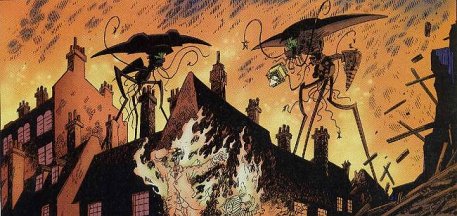 There are all
sorts of references, we see Thoats and Green Men, Gulliver's flying carpet
and his Hither people, C.S. Lewis' Sorns make an appearance, there's a
reference to Moorcock's Michael Kane and Varnal. Wells' Crystal Eggs show
up. Moore loves doing these things.
There are all
sorts of references, we see Thoats and Green Men, Gulliver's flying carpet
and his Hither people, C.S. Lewis' Sorns make an appearance, there's a
reference to Moorcock's Michael Kane and Varnal. Wells' Crystal Eggs show
up. Moore loves doing these things.
The adventure ends with Carter and Jones victorious, pawing through
the wonders left behind, and realizing too late that the cursed mollusks
have launched their damnable ships towards Earth.
Sadly, after this, all the action takes place on Earth and neither John
Carter nor Gulliver Jones make any further appearances. However,
the Sarmak Martians are on Earth, and there's all sorts of plots and Victorian
in-jokes to keep things going.
As to how the portrayals work, it is fairly hit and miss.
The portrayals seem unmistakably British. Gulliver Jones comes across
as a bit wan and indecisive, a sort of Laurence of Arabia, a bit prone
to whining. He doesn't seem at all like the casual drunken lout and
petty thief of the novel. In the comic, he is seen riding on his
carpet Arabian nights style, while in the novel it wraps around him like
a cocoon. His wardrobe is obviously patterned on the desert Bedouin.
Meanwhile John Carter has no hint of the southern gentleman or gold
prospecting cowboy. Rather, in look or dress, he resembles and acts
like an old British East India Company warlord, and dresses like one of
those British Rajahs. There are little difference, the thoats have
clawed feet, stuff like that. Moore's tributes are not slavish,
but give the whole thing a distinctly British taste.
But heck, Moore is just about the finest comic writer who ever lived,
so this is cool and worth picking up.
WAR
OF THE WORLDS: GLOBAL DISPATCHES
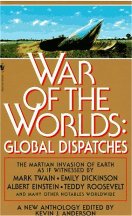 This is a modern
collection of stories about H.G. Wells' war of the worlds told by a group
of modern writers, some of them adopting historical styles.
There is, for instance, a story about H.P. Lovecraft meeting the Martian
invaders, another about Jack London, yet another focuses on the Imperial
Court of the Chinese Dowager as the Martians invade China (you don't actually
see many Martians in that one, they're basically offstage).
It's a real mixed bag, with some real names.
This is a modern
collection of stories about H.G. Wells' war of the worlds told by a group
of modern writers, some of them adopting historical styles.
There is, for instance, a story about H.P. Lovecraft meeting the Martian
invaders, another about Jack London, yet another focuses on the Imperial
Court of the Chinese Dowager as the Martians invade China (you don't actually
see many Martians in that one, they're basically offstage).
It's a real mixed bag, with some real names.
It's got the strengths and weaknesses of such a collection, which, sadly
tend to be mostly weaknesses. What usually happens is this.
Some Editor, or bright young (or middle aged) thing, in this specific case,
Kevin J. Anderson, gets a smashing idea for an anthology, something fun
and funky. Alternate Robin Hoods, Horror Stories About Satanic Metal
Bands, Alternate Universe Elvises, etc. The idea is that it's a catchy
notion that you can wrap a bunch of stories around and it will just jump
off the shelf.
For the most part, the generic or broadly focused anthology, which simply
goes out and looks for a bunch of really good stories is pretty much dead.
Nowadays, it's all got to have a gimmick. Martin Greenberg
is or was pretty big with these gimmick anthologies. I assume it's
publisher driven, or perhaps pitch driven, with guys like Greenberg selling
the idea for these anthologies the way other writers sell novels.
It's cool, they usually have contacts, reputations, the publishers can
usually rely on a reasonable product delivered on deadline.
The big gimmick here, of course, is that War of the Worlds is
in public domain, it's a famous novel, so it's kind of a free for all.
Then the Editor goes around, usually to one of the major conventions,
and knocks on his favourite writers, or rounds up his friends to fill it.
A lot of these anthologies get filled up late night over drinks.
It's often invitation only, the Editor may even pursue a favoured writer.
If it's opened to submissions, it's only after key spaces have been filled
with friends or names, and then it's pretty much cutthroat, particularly
if you're not a name.
The result is a gimmick driven commercial product, no more, no less.
For the most part, you won't get something really satisfying.
A shared universe anthology sets enough ground rules to really have a chance
at momentum, a single author anthology has a consistent voice, a good general
anthology with a loose theme can select among the best to reprint.
This? This is just something to put on the shelves for six
weeks or however long and make a buck. If this pisses someone
in the industry off, well, I'm sorry, but get over it.
So, the War of the Worlds anthology? Pretty hit and miss,
more miss than hit. Particularly, it can be annoying where writers
pretentiously try to ape a really distinctive voice. (I'm thinking
of you, Jack London and H.P. Lovecraft guys). That's simply
honestly hard to carry off well. On the other hand there are
some worthwhile stories, and there are plenty of Sarmak Martians.
Most notable in the anthology (placed generically in the middle, illustrating
the relative grab bag incoherence of the anthology), is a short story by
George Alec Effinger actually set on Mars itself. The only story
set on Mars. In it, we discover that this Mars is inhabited
not only by tentacled monstrosities, but by John Carter, Dejah Thoris,
Helium, Gathol and the whole nine yards. It's Barsoom, ladies
and gentlemen! Dejah Thoris is mysteriously kidnapped, John Carter
is hot on the trail, and he makes a shattering discovery.... The
tentacled Martians are an obscure but evil race, plotting to conquer not
just Earth, but their own native Barsoom as well. Effinger
finally gives us a name for these critters: Sarmaks.
Sadly, it's only a short story, so it tries to play like the first few
chapters of a Burroughs adventure and then it leaves us trapped with a
cliffhanger.
It's tempting, my god but it's tempting, to try and read Effinger's
short story and Alan Moore's comic together. Effinger's is
the beginning, and Moore gives us the end, leaving only a detailed middle
for us to imagine. Indeed, if you want to read it like that,
there's nothing stopping you at all.
On the downside, Effinger is trying to ape Burroughs' style, and he
doesn't quite pull it off. Oh the language, the tropes are all there,
but it lacks the verve and sizzle of the real Burroughs.
RAINBOW
MARS
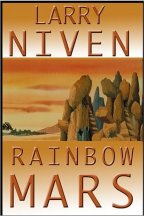 Rainbow Mars
is perhaps the most thoroughgoing fun of the set. The premise
is simple. Time travel is scientifically impossible. It's fantasy,
so being fantasy, his time travellers go back, not to real history, but
to myth and folklore. Niven in the '70s or '80s produced a
whole series of short stories about a time traveller called Svetz.
Svetz was a hapless fellow in a barren future where the only animals left
were dogs, the air was so polluted as to be unbreathable, and the Secretary
General
of the United Nations had evolved not only into an absolute monarch, but
into a dynasty of utterly childish incompetents.
Rainbow Mars
is perhaps the most thoroughgoing fun of the set. The premise
is simple. Time travel is scientifically impossible. It's fantasy,
so being fantasy, his time travellers go back, not to real history, but
to myth and folklore. Niven in the '70s or '80s produced a
whole series of short stories about a time traveller called Svetz.
Svetz was a hapless fellow in a barren future where the only animals left
were dogs, the air was so polluted as to be unbreathable, and the Secretary
General
of the United Nations had evolved not only into an absolute monarch, but
into a dynasty of utterly childish incompetents.
Svetz' job was to go back in time and retrieve animals for the Secretary
General's menagerie. Only, it turns out that the pictures in the
old records are terribly inaccurate. The horse has a single
ferocious horn protruding from its forehead and can only stand to be around
virgins, the gila monster turned out to be forty feet long and fire breathing,
you get the idea.
This time out, Svetz gets to star in a whole novel. He's sent
off to Mars in the remote past for some reason. When he arrives,
he finds a world tree, a tree so tall that its upper level is actually
in geosynchronous orbit. It's a living sky hook. Unfortunately,
it turns out that it's also a predator. The tree's purpose
is to suck all the water out of a planet and then take off to the next
water bearing planet, and eventually to interstellar space and the next
solar system. Bad luck for whoever's living on a world that's left
a dry husk. The world tree is busily turning Mars into
the dead moonscape world that the pioneer probes find. And
there's a problem: When it finishes Mars, the tree starts heading
to Earth...
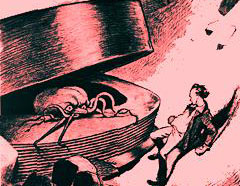 In the meantime,
Svetz gets to take a tour of Mars. Once again, we meet the
Sarmaks, who Niven calls Softfingers. Not only do they stomp
around on tripods, but they also fly those wicked flying saucers.
In Niven's pocket universe, they tried for two invasions of Earth, back
around 1900 and then again in 1950 (the time of the movie version of War
of the Worlds, though the movie Martians were clearly a different species).
They don't talk much, but they're happy little campers. It turns
out it wasn't bacteria that killed them, but gravity... Earth's gravity
eventually caused their internal membranes to break and so they died from
respiratory failure or internal bleeding.
In the meantime,
Svetz gets to take a tour of Mars. Once again, we meet the
Sarmaks, who Niven calls Softfingers. Not only do they stomp
around on tripods, but they also fly those wicked flying saucers.
In Niven's pocket universe, they tried for two invasions of Earth, back
around 1900 and then again in 1950 (the time of the movie version of War
of the Worlds, though the movie Martians were clearly a different species).
They don't talk much, but they're happy little campers. It turns
out it wasn't bacteria that killed them, but gravity... Earth's gravity
eventually caused their internal membranes to break and so they died from
respiratory failure or internal bleeding.
There are also a nice assortment of other Martians. Stanley Weinbaum's
hopping birds and pyramid monster from A Martian Odyssey pass through.
C.S. Lewis' Sorns and Pfiltriggi also make an appearance, and the Pfiltriggi
(along with other species, including the Sarmaks) have the gumption to
ride the world tree to Earth. Heinlein's Martian elders are referred
to, but not seen. There's a tip of the hat to Moorcock's Martian
series so subtle I almost missed it when a character refers to an ancient
Dead City in the Desert identified by a green cross. Svetz
walks through dead or abandoned Martian cities and dwellings, including
perhaps, some from Bradbury.
But when it hits Burroughs, Niven really goes to town. A
robot probe visits one of the cities of the Red Martians, astonished by
turns that (a) they look completely human, (b) they're nudists, (c) they're
egg layers judging by an egg in a perambulator, and (d) they're armed to
the teeth, violent and not inclined to allow their eggs to be touched.
In a chilling, but thoroughly Nivenesque touch, another of the probes
trudging along in the waters of the canal discovers that the canal bottom
is filled with corpses and skeletons, most of whom bear the marks of violent
death. It's a really nice touch, because it brings home to
us how truly murderous John Carter's beloved Martian society is by our
own standards. Niven keeps a cool distance from his Red Martians.
Later on of course, Svetz is captured by the Red Martians and gets a
window into their feudal world view while they and their airship fight
a running battle with a Sarmak ship. The only quibble I have
is that his Martian is named Matthias, which is thoroughly un-Barsoomian.
But who knows, maybe it's a reference. The Red Martians ride to Earth
as well, on the murderous world tree.
At other points, Svetz spots strange creatures, humanoid but with large
detachable heads. Obviously Kaldanes and Rykors. They
too ride the world tree, but are only seen from a distance.
On the other hand, the Green Men of Mars make an appearance, and one of
them even has a significant supporting role. In Niven's conception,
the Green Men are evolved giant insects, and they even have a few remnants
of their exoskeletal plates (though they're mostly endoskeletal these days).
Apart from a few little decorative vestigial plates, the only wrinkle is
that they breath through spiracles in their chest. These two
ride the world tree.
Finally, while wandering around in the desert, Svetz finds himself attacked
by not one, but two sets of ferocious multi-legged predators.
They're fierce, to see is to attack. They're obviously Calots or
perhaps Banths by the sounds of them. Niven has a great explanation
for all the legs... Lower gravity, in low gravity, lots of shorter
legs allows you to go faster than a few long legs.
Niven's Mars is a heterogeneous world, with every single Martian he
can get his hands on crammed into there. I'm astonished he didn't
find a place for Bugs Bunny’s Marvin. But Barsoom is well represented
there, with three races, cities and multi-legged critters.
Fortunately, Niven doesn't make the mistake of Anderson or Effinger,
rather, he follows Chandler and Moore. He's not trying to be Wells
or Burroughs, he's Niven writing his characters as Niven, while remaining
faithful and respectful of the works of other writers. And
he's got the wit and imagination to throw in his own story.
It's a fun, engaging, lighthearted piece of work.
And as a final reference, the Rainbow Mars title is a tribute
to Kim Stanley Robinson's ponderous Green Mars series.
ROBERT
A. HEINLEIN'S NUMBER OF THE BEAST
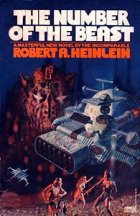 This features
three characters who are named Captain Zebediah John Carter and Dejah Thoris
Burroughs, and her dad Jacob Burroughs. They bounce off to
alternate Mars in a dimension hopping spaceship/sports car called the Gay
Deceiver. About ten alternate Earths over, they encounter a
Mars colonized by 19th century Brits and Russians. After they leave,
they realize this might have been Barsoom, and that they were tricked by
the telepathic Barsoomians who fed them a false landscape.
Oh, and there are apparently Sarmak Martians somewhere, either on some
other Mars or on this one.
This features
three characters who are named Captain Zebediah John Carter and Dejah Thoris
Burroughs, and her dad Jacob Burroughs. They bounce off to
alternate Mars in a dimension hopping spaceship/sports car called the Gay
Deceiver. About ten alternate Earths over, they encounter a
Mars colonized by 19th century Brits and Russians. After they leave,
they realize this might have been Barsoom, and that they were tricked by
the telepathic Barsoomians who fed them a false landscape.
Oh, and there are apparently Sarmak Martians somewhere, either on some
other Mars or on this one.
Look, I'm going to be level with you. A human life is long
enough to read the first ten pages of this book, just to see how its going.
But life is just too short to read the whole goddamned thing.
THE
MARTIAN WAR
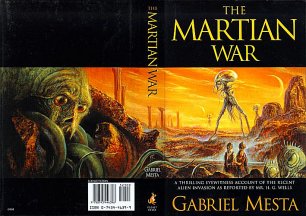 The Martian
War by Kevin Anderson (writing as Gabriel Moesta) gets an honourable
mention. This is a crossover adventure, but it does not
introduce the Sarmaks to Barsoom. Rather, it's confined to
H.G. Wells and his creations.
The Martian
War by Kevin Anderson (writing as Gabriel Moesta) gets an honourable
mention. This is a crossover adventure, but it does not
introduce the Sarmaks to Barsoom. Rather, it's confined to
H.G. Wells and his creations.
Anderson's conceit is that Percival Lowell (real character) and Doctor
Moreau (from Wells' Island of Doctor Moreau) wind up together and
capture a live Sarmak Martian (together with corpses of another tentacled
Martian and dozens of strange humanoids), which they try to communicate
with. Moreau reports his experiences in a journal.
Occurring later on, H.G. Wells and his old university Professor Huxley,
zip off in Professor Cavour's anti-gravity sphere, visiting the Moon and
then Mars. It seems that Huxley's been organizing a kind of
Victorian super-weapons project. Among the scientists, in addition
to Cavour and Huxley are Griffin, who becomes the invisible man (and is
secretly a deranged Russian agent) and those guys from Food of the Gods
(although they're just comic relief who barely appear).
Wells’ story takes place well after Moreau's, and in fact, as his storyline
is going along, he's reading Moreau's journal, but the two stories are
told in parallel. It's just one of the many problems with the work.
Although there's no sign of any of Burroughs characters or settings, for
some reason, Anderson tries to stitch a Burroughs-style adventure onto
the stilted dialogue and a kind of bloodless formalism that he seems to
feel is a reasonable facsimile of Wells' style. You can see
the tissue rejection setting in as you watch.
The humanoid Martians turn out to be Lunarians, who have been kidnapped
en masse by the Sarmaks in order to have an effective work force.
I suppose we could speculate that if the Martians needed to go out and
kidnap Lunarians to do their work, they may have had a prior race of humanlike
slaves, but frankly, there's little or nothing to support that.
It's clever in spots, and there's bits of good, even evocative description.
But having got all dressed up, Anderson really has no place to go, and
drifts slowly into cheap hackneyed cliché and even more hackneyed
plot.
His story owes less to Wells than to writers like George Griffiths or
Garret P. Serviss, who were Wells contemporaries. Don't remember
them? There's a reason for that. Wells saw his stories
as a way to be subversive, a way to comment upon life, to criticize, to
reflect. There was a deeper level to Wells, or to Burroughs
that simply isn't found here.
Like Griffiths or Serviss, there is no questioning, there is no reflection.
There's no pondering the meaning of the Martians, they're just bad.
The Lunarians, they're good. Wells is good. Huxley is good.
Wells' girlfriend is good. Lowell is good, but a bit foolish.
Griffin is not only bad, but he's obnoxiously bad.... he runs around thinking
he's invisible when he's not (a gag borrowed from Amazon Women on The
Moon). The whole thing is a mile wide and an inch deep.
Basically, it's a nice idea, but trite handling kills it dead.
In some ways, it reminded me of George H. Smith's Second War of the
Worlds in terms of the whole 'just not getting the point' vibe.
Anderson compounds his mistake by trying to write in Wells' style.
Well, sorry, Wells style is antique and doesn't play well nowadays, we
don't read Wells for his prose, but for the fact that he was actually saying
something.
As I've pointed out, it's hard to work in another writer's style.
It's even harder to do it successfully. Anderson doesn't make
the grade.
I dunno, it's sort of a manual for how not to do this sort of thing.
If you're interested in these sorts of crossover pastiches, and they can
be a lot of fun, I'd recommend Kim Newman or Allan Moore.
~ Den Valdron
4,800 words


